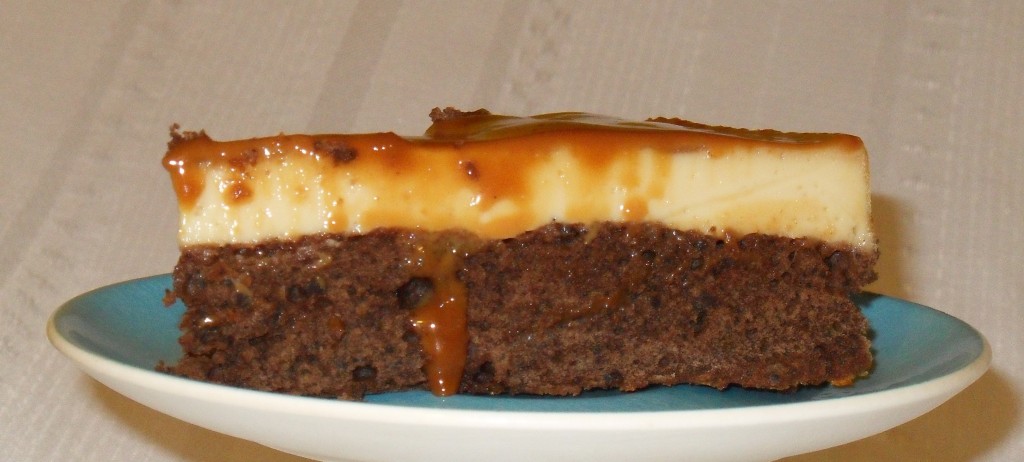Impossible Cake (AKA chocoflan)Pastel Imposible (AKA Chocoflan)
Rick Bayless
Serves 12 generously
Recipe from Season 6 of Mexico–One Plate at a Time
Ingredients
For the mold:
A little softened butter and some flour
1 cup store-bought or homemade cajeta (goat milk caramel)
For the cake:
3 ½ ounces (7 tablespoons) butter, slightly softened
¾ cup sugar
1 egg
1 tablespoon espresso powder dissolved in 1 tablespoon hot water
Or 2 tablespoons espresso
½ cup all-purpose flour
¾ cup cake flour
½ teaspoon baking powder
½ teaspoon baking soda
¼ cup cocoa powder (I like the more commonly available—not Dutch process—cocoa best here)
¾ cup buttermilk
For the flan:
1 12-ounce can evaporated milk
1 14-ounce can sweetened condensed milk
4 eggs
1 teaspoon pure vanilla extract, preferably Mexican vanilla
Directions
Prepare the mold. Turn on the oven to 375 degrees and position the rack in the middle. Generously butter the bottom and sides of a 10-inch round cake pan (you need one that’s 3 inches deep), sprinkle with flour, tip the pan, tapping on the side of the counter several times, to evenly distribute the flour over the bottom and sides, then shake out the excess. Microwave the cajeta for 30 seconds to soften it, then pour over the bottom of the pan, tilting the pan to coat the bottom evenly. Set a kettle of water over medium-low heat. Set out a deep pan that’s larger than your cake pan (a roasting pan works well) that can serve as a water bath during baking.
Make the cake batter. With an electric mixer (use the flat beater, if yours has a choice), beat the butter and sugar at medium-high speed until light in color and texture. Scrape the bowl. Beat in the egg and espresso. Sift together the all-purpose and cake flour, baking powder, baking soda and cocoa. With the mixer on medium-low, beat in about ½ of the flour mixture, followed by ½ of the buttermilk. Repeat. Scrape the bowl, then raise the speed to medium-high and beat for 1 minute.
Make the flan mixture. In a blender, combine the two milks, the eggs and the vanilla. Blend until smooth.
Layer and bake. Scrape the cake batter into the prepared cake pan and spread level. Slowly, pour the flan mixture over the cake batter. (I find it easiest to pour the mixture into a small ladle, letting it run over onto the batter.) Pull out the oven rack, set the cake into the large pan, then set both pans on the rack. Pour hot water around the cake to a depth of 1 inch. Carefully slide the pans into the oven, and bake about 45 to 50 minutes, until a toothpick inserted into the cake comes out dry. Remove from the water bath and cool to room temperature, about 1 hour.
Serving. Carefully run a thin-bladed knife around the edge of the cake/flan to free the edges. Invert a rimmed serving platter over the cake pan, grasp the two tightly together, then flip the two over. Gently jiggle the pan back and forth several times to insure that the cake/flan has dropped, then remove the pan. Scrape any remaining cajeta from the mold onto the cake.
My notes- *I had to heat my cajeta a little more to make spreadable.
*When I was spreading cajeta(I tried tilting pan didn’t work for me) with a off set spatula, it kinda starts to pick up the butter and flour- so I just gently patted it down to spread. *Mine took a little longer to cook. * Also give it the full hour to cool in pan.


This recipe gave me the technique to get the custard layers of the cake perfectly baked. Thank you Rick! I watch your shows & it’s so interesting . A foodie myself & a published cook book to my credit.